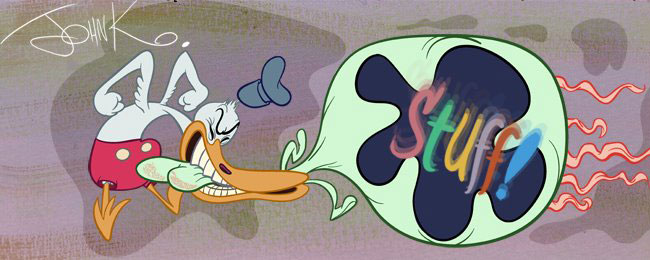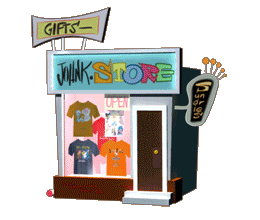Experience and study is as important as talent
When I was young and ignorant, I was like everyone else who is young and ignorant. I thought I knew everything. So because I thought I could just sell my own shows and produce them without knowing how things worked I was developing characters on the side constantly.




 In the meantime, while nursing my dreams of grandeur I amassed lots of experience in every department in various animation studios.
In the meantime, while nursing my dreams of grandeur I amassed lots of experience in every department in various animation studios.I inbetweened and animated on commercials, did storyboards for Filmation, layouts for everyone in town, wrote shorts and movies for Ralph Bakshi and designed characters for different studios. I devised a new layout system while working on the New Jetsons, as a way to get more acting and life into the Hanna Barbera factory system.
I designed character models on crummy shows, then got into the development department at TMS and Hanna Barbera where I would see how the ideas we thought were good would come out on screen later:
 Not only that, but I was inspired by all the classic cartoons and studied them frame by frame, copied them, analyzed them and read everything I could about how the cartoons were made.
Not only that, but I was inspired by all the classic cartoons and studied them frame by frame, copied them, analyzed them and read everything I could about how the cartoons were made.Before I ever got to make one of my own series, I learned how each department worked (or didn't work) and how they all fit into the overall production. Plus I met and worked with many talented artists and learned what people's special talents were.
TO DEVELOP AN EFFICIENT PRODUCTION SYSTEM
Know How Animation Production Systems Work - good and bad
I had worked on bad cartoons for years in a bad production system, but studied the good old cartoons and mingled with the classic cartoonists and learned as much as I could how they made their cartoons the right way.

TV production systems were creatively inefficient in the 1980s (as they have become again in the 2000s).
They were designed to undo anything creative that might have accidentally appeared in any of the assembly line departments.
The Looney Tunes production system on the other hand was extremely creatively efficient. It was designed to take advantage of talented artists and to get their best work on the screen.
It was built to evolve and improve. Watching cartoons from the 1930s and 1940s, you can see them get progressively more sophisticated and funny almost month by month.


 On the other hand, Cartoons from the 60s to the late 80s stagnated or got worse with time - not only because of conservatism at the top, but because of the way the production system was set up.
On the other hand, Cartoons from the 60s to the late 80s stagnated or got worse with time - not only because of conservatism at the top, but because of the way the production system was set up.  You could have had an army of super talented cartoonists on staff (as Filmation did for a short period in the early 80s) and still not produce anything that reflected the talent or individuality of the contributors.
You could have had an army of super talented cartoonists on staff (as Filmation did for a short period in the early 80s) and still not produce anything that reflected the talent or individuality of the contributors.I'll go into this more in its own post.
A studio and a shorts program needs more than just talent in order to succeed and produce stars. Both star characters and star talent. They need to give the talent an environment where they can thrive and get experience and have some room to experiment.
TO LEARN FROM MISTAKES AND SUCCESSES
to be continued....
http://johnkstuff.blogspot.com/2009/03/goals-of-shorts-program-3-to-discover.html




